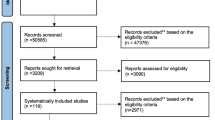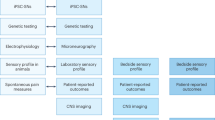Key Points
-
Virtually all new analgesics approved over the past 25 years are derivatives or reformulations of opioids or aspirin-like drugs, existing drugs given for a new indication or older drugs given by a different route of administration. As a consequence, pain-related conditions frequently lack effective therapy.
-
In this Perspective, we discuss factors contributing to the lack of innovation in therapies for pain and advocate public–private partnerships to translate new knowledge into more efficacious and safer treatments.
-
Factors confounding this lack of innovation include: assessing compounds with new mechanisms of action, using animal models that have been validated with older prototypic drugs, conducting proof-of-concept studies in clinical models that may not readily extrapolate to chronic pain syndromes and evaluating new drugs with group measures of central tendency and variation that may limit our understanding on how to manage the individual patient's pain.
-
Recognition of the multiplicity of cells, receptors and genetic changes involved in pain processing suggests that analgesic drug development may be reinvigorated by targeting multiple events and determining which series or combinations of targets yield effective analgesia for specific diseases and diverse patients.
-
Development of responder approaches might identify drugs with therapeutic value for chronic pain that is resistant to normal therapies and identify molecular–genetic markers for predicting analgesic drug actions in individual patients.
-
Clinical outcomes, such as pain, that require consideration of more than one endpoint may be assessed better with a composite approach that is able to encompass and accommodate these variables. This approach has the advantage of grouping clinically important outcomes into a metric that defines the response of the individual, not the individual's contribution to the group outcome.
-
The US Food and Drug Administration's Critical Path Initiative for medical product development spans the continuum from prototype design or discovery, through preclinical and clinical development to approval and product launch. Progress in critical path pain-related research is dependent on the development of consortia to organize public–private partnerships and identify resources to start the process of improving pain therapy through the development of better and safer drugs.
Abstract
Biomedical science has greatly improved our understanding of pain in recent decades, but few novel molecular entities that address fundamentally new pain mechanisms have entered the clinic, despite dramatically increased pharmaceutical investment. Indeed, virtually all new analgesics approved over the past 25 years are derivatives or reformulations of opioids or aspirin-like drugs, existing drugs given for a new indication or older drugs given by a different route of administration. Here, we discuss factors contributing to this lack of innovation in therapies for pain and advocate public–private partnerships (PPPs) to translate new knowledge into more efficacious and safer treatments.
This is a preview of subscription content, access via your institution
Access options
Subscribe to this journal
Receive 12 print issues and online access
$209.00 per year
only $17.42 per issue
Buy this article
- Purchase on Springer Link
- Instant access to full article PDF
Prices may be subject to local taxes which are calculated during checkout


Similar content being viewed by others
References
Dionne, R. A. & Witter, J. NIH-FDA analgesic drug development workshop: translating scientific advances into improved pain relief. Clin. J. Pain 19, 139–147 (2003).
Dionne, R. A., Bartoshuk, L., Mogil, J. & Witter, J. Individual responder analyses for pain: does one pain scale fit all? Trends Pharmacol Sci. 26, 125–130 (2005).
Scholz, J. & Woolf, C. J. Can we conquer pain? Nature Neurosci. Suppl. 5, 1062–1067 (2002).
Watkins, L. R. & Maier, S. F. Glia: A novel drug discovery target for clinical pain. Nature Rev. Drug Discov. 2, 973–985 (2003).
Watkins, L. R., Hansen, M. K., Nguyen, K. T., Lee, J. E. & Maier, S. F. Dynamic regulation of pro-inflammatory cytokine, interleukin-1β: molecular biology for non-molecular biologists. Life Sci. 65, 449–481 (1999).
Salter, M. W. Cellular signalling pathways of spinal pain neuroplasticity as targets for analgesic development. Curr. Topics Med. Chem. 5, 557–567 (2005).
Xu J.-T. et al. P38 activation in uninjured primary afferent neurons and in spinal microglia contributes to the development of neuropathic pain induced by selective motor fiber injury. Exper. Neurology 204, 355–365 (2007).
Ji, R.-R. & Wen, Y.-R. Neural–glial interaction in the spinal cord for the development and maintenance of nerve injury-induced neuropathic pain. Drug Develop. Res. 67, 331–338 (2006).
Tong, S. E., Daniels, S. E., Montano, T., Chang, S. & Desjardins, P. SCIO-469, a novel P38A MAPK inhibitor, provides efficacy in acute post-surgical dental pain (abstract). Clin. Pharmacol. Therap. 75, P3 (2004).
Roses, A. D. Pharmacogenetics and drug development: The path to safer and more effective drugs. Nature Rev. Genet. 5, 645–656 (2004).
Searls, D. B. Pharmacophyogenomics: genes, evolution and drug targets. Nature Rev. Drug Discov. 2, 613–623 (2003).
Debouck, C. & Metcalf, B. The impact of genomics on drug discovery. Annu. Rev. Pharmacol Toxicol. 40, 193–207 (2000).
Kim, H. et al. Genetic influence on variability in human pain sensitivity associated with gender, ethnicity and psychological temperament. Pain 109, 488–496 (2004).
Gilron, I., Max, M. B., Lee, G., Booher, S. L. & Dionne, R. A. Effects of the AMPA/kainate antagonist LY293558 on spontaneous and evoked postoperative pain. Clin. Pharmacol Therap. 68, 320–327 (2000).
Eddy, N. B. & May, E. L. The search for a better analgesic. Science 181, 407–414 (1973).
Vane, J. R. Inhibition of prostaglandin synthesis as a mechanism of action for aspirin-like drugs. Nature New Biol. 231, 232–235 (1971).
Wolfe, M. M., Lichenstein, D. R. & Singh, G. Gastrointestinal toxicity of non-steroidal anti-inflammatory drugs. N. Engl. J. Med. 340, 1888–1899 (1999).
Silverstein, F. E. et al. Gastrointestinal toxicity with celecoxib vs. nonsteroidal anti-inflammatory drugs for osteoarthritis and rheumatoid arthritis: the CLASS study: a randomized controlled trial. Celecoxib Long-Term Arthritis Safety Study. JAMA 284, 1247–1255 (2000).
Bombardier, C. et al. Comparison of upper gastrointestinal toxicity of rofecoxib and naproxen in patients with rheumatoid arthritis. VIGOR Study Group. N. Engl. J. Med. 343, 1520–1528 (2000).
Fitzgerald, G. A. Coxibs and cardiovascular disease. N. Engl. J. Med. 351, 1709–1711 (2004).
Psaty, B. M., Furberg, C. D. COX-2 inhibitors — Lessons in drug safety. N. Engl. J. Med. 352, 1133–1135 (2005).
Thase, M. E., Entsuah, A. R. & Rudolph, R. L. Remission rates during treatment with venlafaxine or selective serotonin reuptake inhibitors. Br. J. Psychiatry 178, 234–241 (2001).
Wong, M. L. & Licino, J. From monoamines to genomic targets: a paradigm shift for drug discovery in depression. Nature Rev. Drug Discov. 3, 136–151 (2004).
Entsuah, A. R., Huang, H. & Thase, M. E. Response and remission rates in different subpopulations with major depressive disorder administered venlafaxine, selective serotonin reuptake inhibitors or placebo. J. Clin. Psychiatry 62, 869–877 (2001).
Reidenberg, M. M. Evolving ways that drug therapy is individualized. Clin. Pharmacol Therap. 74, 197–202 (2003).
Lesko, L. J. Paving the critical path: how can clinical pharmacology help achieve the vision? Clin. Pharmacol. Therap. 81, 170–177 (2007).
Rowbotham, M. C. Mechanisms of neuropathic pain and their implications for the design of clinical trials. Neurology 65 (Suppl. 4), 66–73 (2005).
Coghill, R. C., MeHaffie, J. G. & Yen, Y. F. Neural correlates of interindividual differences in the subjective experience of pain. Proc. Natl Acad. Sci. USA 100, 8538–8542 (2003).
Coghill, R. C. & Eisenach, J. Individual differences in pain sensitivity: Implications for treatment decisions. Anesthesiology 98, 1312–1314 (2003).
Ploghaus, A., Becerra, L., Borras, C. & Borsook, D. Neural circuitry underlying pain modulation: expectation, hypnosis, placebo. Trends in Cogn. Sci. 7, 197–200 (2003).
Gagliese, L. & Katz, J. Age differences in postoperative pain are scale dependent: a comparison of measures of pain intensity and quality in younger and older surgical patients. Pain 103, 11–20 (2003).
Giles, B. E. & Walker, J. Sex differences in pain and analgesia. Pain Rev. 7, 181–193 (2000).
Berkley, K. J. Sex differences in pain. Behav. Brain 20, 371–380 (1997).
Naliboff, B. K. et al. Sex-related differences in IBS patients: central processing of visceral stimuli. Gastroenterology 124, 1738–1747 (2003).
Mogil, J. S., Chesler, E. J., Wilson, S. G., Juraska, J., & Sternbery, W. Sex differences in thermal nociception and morphine antinociception in rodents depend on genotype. Neurosci. Biobehav. Rev. 24, 375–389 (2000).
Mogil, J. S. et al. The melanocortin-1 receptor gene mediates female-specific mechanisms of analgesia in mice and humans. Proc. Natl Acad. Sci. USA 27, 4897–4872 (2003).
Bartoshuk, L. M. et al. From psychophysics to the clinic: missteps and advances. Food Qual. Prof. 15, 617 (2004)
Aubrun, F., Langeron, O., Quesnel, C., Coriat, P. & Riou, B. Relationship between measurement of pain using visual analog score and morphine requirements during postoperative intravenous morphine titration. Anesthesiology 98, 1415–1421 (2003).
Parexel's Pharmaceutical R&D Statistical Sourcebook 2005/2006 (Parexel International, Waltham, Massachusetts, 2006).
Turk, D. C. et al. Core outcomes for chronic pain clinical trials: IMMPACT recommendations. Pain 106, 337–345 (2003).
Dworkin, R. H. et al. Core outcome measures for chronic pain clinical trials: IMMPACT recommendations. Pain 113, 9–19 (2005).
Turk, D. C. et al. Developing patient-reported outcome measures for pain clinical trails: IMMPACT recommendations. Pain 125, 208–215 (2006).
Lee, Y. -S., Kim, H., Wu, T. –X., Wang, X. -M. & Dionne, R. A. Genetically mediated interindividual variation in analgesic responses to cyclooxygenase inhibitory drugs. Clin. Pharmacol. Ther. 79, 407–418 (2006).
Author information
Authors and Affiliations
Corresponding author
Ethics declarations
Competing interests
The authors declare no competing financial interests.
Related links
Glossary
- Cyclooxygenase-2
-
(COX-2). An enzyme that is expressed in cell membranes in response to tissue injury and catalyses the formation of pro-inflammatory cytokines from arachidonic acid.
- Item response theory
-
Psychometric models that link patient responses to the probability of an underlying trait.
- Haplotype
-
A combination of alleles or seqquence variations on the same chromosome.
- Non-steroidal anti-inflammatory drugs
-
(NSAIDs). A structurally diverse class of drugs that block the enzymatic activity of cyclooxygenase to produce analgesia.
- Off label
-
The use of an approved drug for a condition that is not mentioned in the original labelling.
- Open-label segment
-
Identification of responders to a known drug by administration prior to randomization into the double-blind phase of a clinical trial.
- Pharmacogenetics
-
The study of genetic variation that results in differing responses to drugs. Pharmacogenetics considers one or a few genes of interest, whereas pharmacogenomics considers the entire genome.
- Plasticity
-
Changes in the nervous system that alter the processing of sensory information to augment or suppress the sensory responses elicited by a fixed input to a potentially painful stimulus.
- Single nucleotide polymorphisms
-
(SNPs). Inter-individual differences in the DNA sequence at a single position in the genome, currently estimated to be greater than 10 million in the human genome. Differences in a single base could change the protein sequence, leading to differences in susceptibility to diseases or therapies.
- Visual analogue scales
-
(VAS). A pain measurement scale consisting of a vertical or horizontal line, which defines a continuous response dimension between two words that anchor each end of the scale, usually 'no pain' at one end and 'worst possible pain' at the other.
Rights and permissions
About this article
Cite this article
Woodcock, J., Witter, J. & Dionne, R. Stimulating the development of mechanism-based, individualized pain therapies. Nat Rev Drug Discov 6, 703–710 (2007). https://doi.org/10.1038/nrd2335
Issue Date:
DOI: https://doi.org/10.1038/nrd2335
This article is cited by
-
Cutoff criteria for the placebo response: a cluster and machine learning analysis of placebo analgesia
Scientific Reports (2021)
-
The emergence of animal models of chronic pain and logistical and methodological issues concerning their use
Journal of Neural Transmission (2020)
-
What intrinsic factors influence responsiveness to acupuncture in pain?: a review of pre-clinical studies that used responder analysis
BMC Complementary and Alternative Medicine (2017)
-
Challenges in translational drug research in neuropathic and inflammatory pain: the prerequisites for a new paradigm
European Journal of Clinical Pharmacology (2017)
-
Targeting Nerve Growth Factor (NGF) for Pain Management: What Does the Future Hold for NGF Antagonists?
Drugs (2014)



